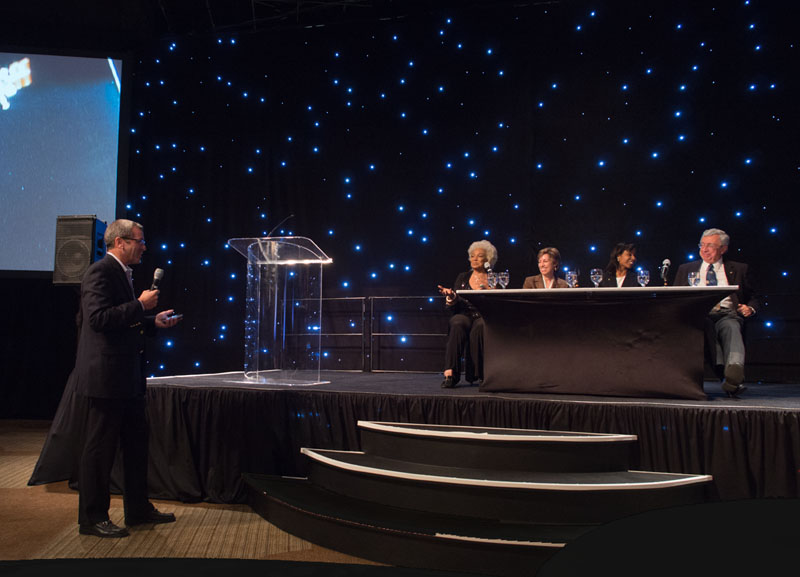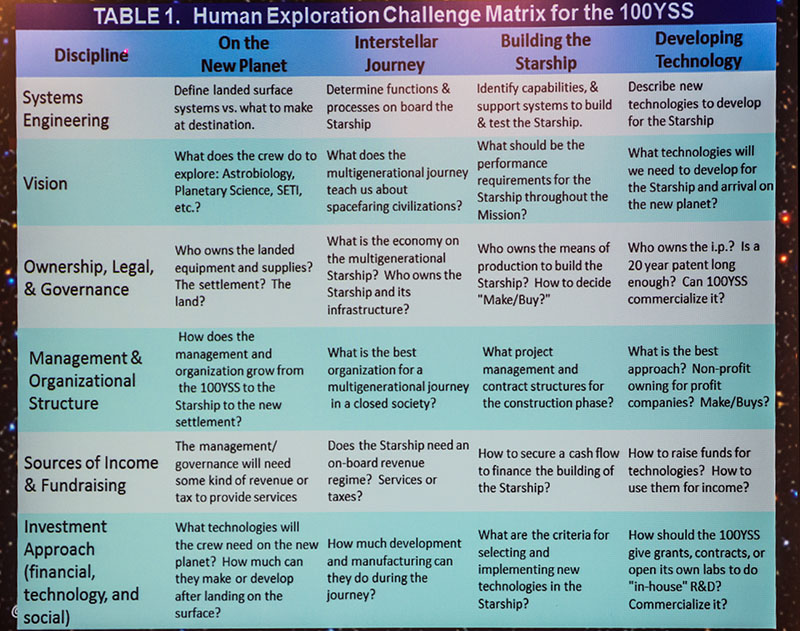This week's column by Ctein
I know I've been neglecting my off-topic
obligations (if they can be called such). Just too much good photographica to write about.
Finally, here's another one (and there'll be a
second part in two weeks). For thems of you whats
hates these, come back next week for more of my
photobabble.
 Miles O'Brien, PBS Newshour science correspondent, interviews an expert panel on the history of the Johnson Spaceflight Center and NASA.
Miles O'Brien, PBS Newshour science correspondent, interviews an expert panel on the history of the Johnson Spaceflight Center and NASA.
Last September, Houston was the site of the first
"private" 100 Year Starship (100YSS) conference.
The previous year's 100 Year Starship conference
was a DARPA-initiated government conference. You
can read my report on it.
This year's conference was the first hosted by
the 100YSS Foundation, established with a DARPA
grant of $500,000 after last year's confab. The
reason for the quote marks around "private" is
that anybody could attend; you merely had to pay
the conference fee.
As I explained previously, DARPA doesn't build
stuff. They spark interesting and innovative
endeavors and then they throw a little money at
private entities to kickstart the thing. Their
interests are national security and defense,
staying ahead of the rest of the world's
technology curve. Forty-something years ago, they
envisioned it might be useful for the Defense
Department to have a robust and distributed
communications network in case war broke out. The
result was something called ARPANET. Ever heard
of it?*
The 100 Year Starship is considerably more
ambitious. Its goal is, over the next century, to
either build and launch a starship or to
establish the technological, industrial,
managerial and economic base that would be
capable of doing so. DARPA doesn't especially
want or need a starship. The myriad
instrumentalities and technologies required to
build such an amazing endeavor, though, would
transform U.S. science, production, and
manufacturing even more radically than the Moon
Race did.
Unfortunately, the path to the stars is much
longer and much less clearly defined than that to
the Moon. I truly cannot speak for all 250
attendees, a substantial fraction of whom were at the first year's DARPA conference, but my sense of it
is that the consensus feels similarly: we all
hope this venture will succeed, and we all expect
this first attempt won't. There are too many ways
it can go wrong, too many mistakes that can be
made. It would require great luck for none of
them to prove fatal to the enterprise. But, one
has to start somewhere, and the objective is to
learn enough so that if the 100YSS fails to
achieve its goal, the next attempt will fare
better.
Which still leaves the problem, how do you do
this? More specifically, at this early stage, how
do you build an organization that could attempt
to do this?
I'm sure that's the problem DARPA faced when they
looked over the request-for-funding proposals
from last year's conference. I heard that there
were close to three dozen submissions. Among the
half-dozen top ones, I doubt there was a single
one that wasn't worthy of funding. They ranged
from "let's start cutting metal tomorrow" (only a
modest exaggeration) to "the problems are still
so ill-defined that we shouldn't jump into
anything."
DARPA decided to go the latter route and awarded
the grant to the proposal from Dr. Mae Jemison
(see my previous column) and The Jemison Group.
In six months they managed to go from getting the
grant to pulling off a major conference. I know a
little something about throwing conferences. When
you're running that fast there will be problems,
and there were a few, but it gets a solid B+. These
people are very good at moving fast. Not so
incidentally, the 2013 conference will be held in
Houston this September. I plan to be
there.
What did this first conference accomplish? Well,
now, that's an interesting question.
Content-wise, very little. That has some people
frustrated (especially the cut-metal set). My
take on it is that this event was mostly about
process—setting up the sociological constraints
and boundary conditions that would facilitate
getting to concrete answers down the road. (Most
interestingly, I realized that this conference
bore substantial similarities to a project I was
involved in over 40 years ago. More on that next
time.)
I'm not privy to the inner workings of the 100YSS
Foundation or their agenda. Three process goals,
though, were clear to me. The first was to create
an intellectual "big tent." When you aren't sure
what the right approach to a problem is, you
don't want to be rejecting possibilities and
talents out of hand. You never know what you'll
need later. You explore as many avenues as
possible, in parallel, and try to avoid tossing
any out prematurely, just because one seems most
promising at the moment.
 So many questions, so few answers. One
speaker's take on just some of the matters that
will need to be addressed to make the 100YSS
project a success.
So many questions, so few answers. One
speaker's take on just some of the matters that
will need to be addressed to make the 100YSS
project a success.
Sounds good in principle. In practice it can be
dicey. For one thing, most people need focus to
accomplish anything. If the immediate problems
and goals seem impossibly diffuse, it's difficult
to get anywhere. It can also lead to mission
creep, where the goal perpetually mutates in ways
that have people spinning their wheels, or leads
them down a garden path they never meant to
follow.
It's also frustrating to the people who have a
clear idea in mind of how the problem should be
solved (whether or not they have the best
answer). They want to get moving on a solution
and tend to be impatient waiting for the Big Plan
to jell. Entirely understandable, unfortunately.
You have to figure out ways to keep those people
happy so they don't leave in frustration.
In fact, several autonomous subgroups
spontaneously appeared from within the conference
attendees—like-minded people who are trying to
pursue their more immediate goals without having
to wait for the entire operation to arrive at
consensus. I have this suspicion that the
Foundation expected that to happen. As I said, a
big tent.
You're also at risk of infiltration by nutters
and crackpots, and you want to make sure they
can't hijack the agenda or appear to be
representative of the group. We had just a couple
of those. I would say that most of the people at
the conference, though, were a lot like me:
smart, educated, with a hard head and a practical
mind, and open to new ideas...but with large
bullshit filters. It's harder to hijack a group
like that. Still, it's a possibility that I'm
sure the Foundation is wrestling with, because
circumstances can change, and dealing with this
potential problem is a complicated process issue.
None of which is to say that the "big tent" is
the wrong approach. Personally, I think it's the
only one that has a chance of working at the
present time. That doesn't mean it isn't fraught
with peril. We'll see how well it works out.
The second goal? I'll get to that in the second
part of this column, in two weeks. A hint—when
I said the people were a lot like me? In some
very important ways, I lied. Ah, the anticipation....
©2013 by Ctein, all rights reserved
*Satire alert
Original contents copyright 2013 by Michael C. Johnston and/or the bylined author. All Rights Reserved. Links in this post may be to our affiliates; sales through affiliate links may benefit this site.
TOP links
(To see all the comments, click on the "Comments" link below.)
Featured Comments from:
Hugh Crawford: "The Ownership, Legal, and Governance part is the most interesting. It sure won't be capitalism as we know it."
John Camp: "I find the concept fascinating, as much for the management problems as for the actual development of a starship. Cutting metal at this point seems absurd, when you don't even know who or what would go to another star. To send off a crippled mission in ten years that wouldn't even be able to report back before it was obsolete seems foolish. (For example, you have to decide exactly what you'd want such a mission to return in the way of results—but the earth-orbit astronomical telescopes are now returning such a wealth of new information that it would seem to me most profitable to try to expand their capabilities, and in x number of years you might be able to find out much of the information that you'd get from an actual probe. I mean, do we really want to spend trillions to send a starship out to a place if it reports back in two hundred years that the target planet is another Mars? In other words, close, but no cigar?)
"It's a great thought problem, though, and would take excellent management just to catalog the relevant thoughts.
"But—$500,000 is trivial. In fact, it's so trivial, that I suspect most of it will be wasted. $500,000 per year might get something done, but not much—that might buy you a three or four-person staff. What we need to do is get rich SF writers, and there are at least a couple of dozen of those, to kick in a tax-deductible 5% of their income to a starship fund...."








